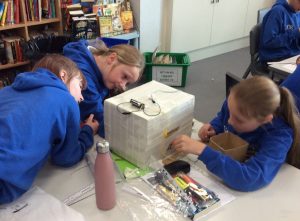Design Technology is an exciting and inspiring subject which challenges children to design and make products which solve real life and relevant problems considering the needs and wants of the user. In Design Technology children will investigate and evaluate currently available products and those of the past exploring what makes them successful. They will learn core skills, techniques and knowledge to help them in their design process to make and evaluate authentic, functional and high-quality products which they can be proud of.
We aim for children who have the required skills and techniques to be confident and collaborative problem solvers and creative designers.
In Design Technology the children’s work encompasses the following areas: Mechanisms (Key Stage 1), Mechanical Systems (Key Stage 2), Structures, Electrical Systems, Textiles and Food.

Aims of Design Technology
- To enable children to develop the creative, technical knowledge and practical expertise needed to perform everyday tasks confidently and to participate successfully in an increasingly technological world;
- To build and apply a repertoire of knowledge, skills, techniques and understanding in order to design and make high-quality products for a wide range of users and purposes;
- To enable children to critique, evaluate and test their ideas and products as well as the work of others;
- Understand and apply the principles of nutrition and learn basic food preparation techniques and learn how to cook simple dishes;
- Encourage a healthy attitude to safety through following correct procedures when using tools and equipment.
Our Approach to Implementing the Design Technology Process
All units of work have the 6 essentials of good practice in DT embedded within them to ensure all learning is genuinely Design and Technology:
- User: children have a clear idea of who they are designing and making products for, considering their needs, wants, interests and preferences;
- Purpose: children know what the products they design and make are for. Each product will perform a clearly defined task that can be evaluated in use;
- Functionality: children will design and make products that function in some way to be successful – products must combine functional characteristics with aesthetic qualities;
- Design decisions: children will have opportunities to make informed decisions such as selecting materials, components and techniques and deciding what form products will take, how they will work, what task they will perform and who they are for;
- Innovation: children will encouraged to be original with their thinking;
- Authenticity: children will design and make products that are believable, real and meaningful to themselves and not replicas, reproductions or models.
Each Design Technology unit of work will follow the same process:
- Investigative and Evaluative Activities
Children will explore and learn about a range of existing products and find out about DT in the wider world.
This can include disassembly of products to explore how they are made and function;
- Focused Tasks
Children are taught specific technical knowledge, techniques, designing and making skills they will need to be successful in their final design task. Children will be able to practice and explore different techniques.
- Design, Make and Evaluate Assignment
Children will design and create their functional product with the user and purpose in mind. They will use the information they learnt during the Investigative and Evaluative Activities and Focused Tasks.
Children will then evaluate the success of their final product in light of the design brief.
Supporting Special Educational Needs and Disabilities
All children with SEND will have equal access and opportunities within the curriculum. The School will support these children to ‘catch up’, ‘keep up’ and experience success in the following ways (where appropriate):
- High quality teaching each day through Ordinarily Available Provision (formerly Quality First Teaching);
- Opportunities for pre-learning (particularly new vocabulary) before lessons;
- Appropriately scaffolded or differentiated work or materials;
- Classrooms and materials set up to reduce cognitive load and follow dyslexia friendly strategies;
- Children with SEND have a Pupil Passport which identifies approaches and strategies to be used which will help them to succeed;
- For children with Education, Health and Care Plans there may be 1:1 adult support in lessons.
The School recognises that while a child may have additional needs in one area of the curriculum they may well have skills and talents which allow them to shine and be successful in another and this is to be celebrated.
To view the Design Technology Curriculum Map please Click Here